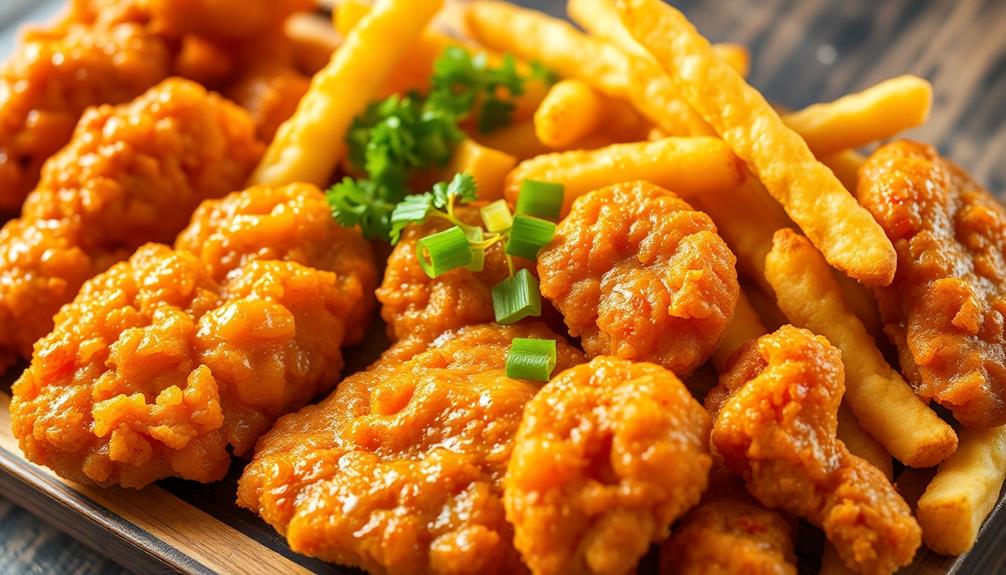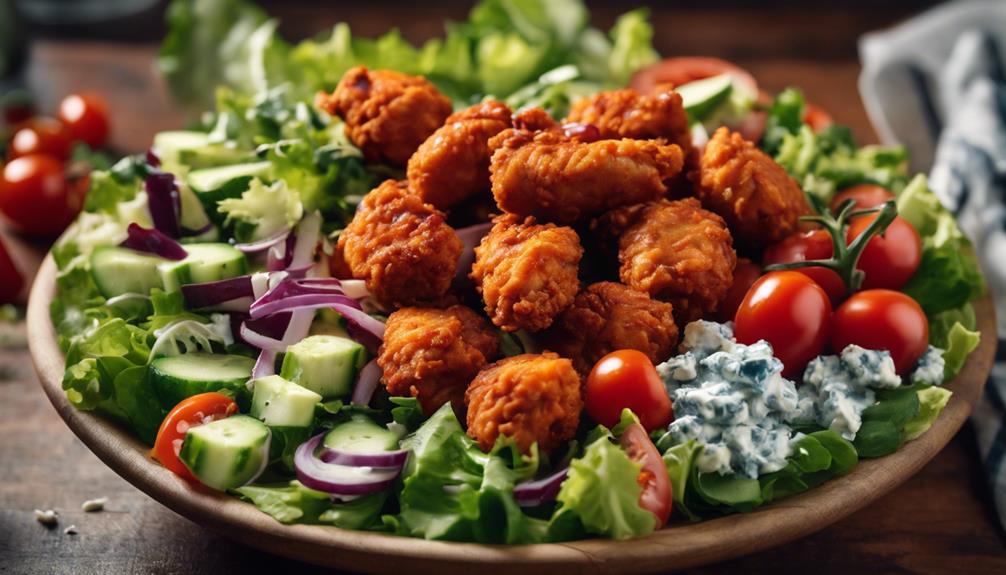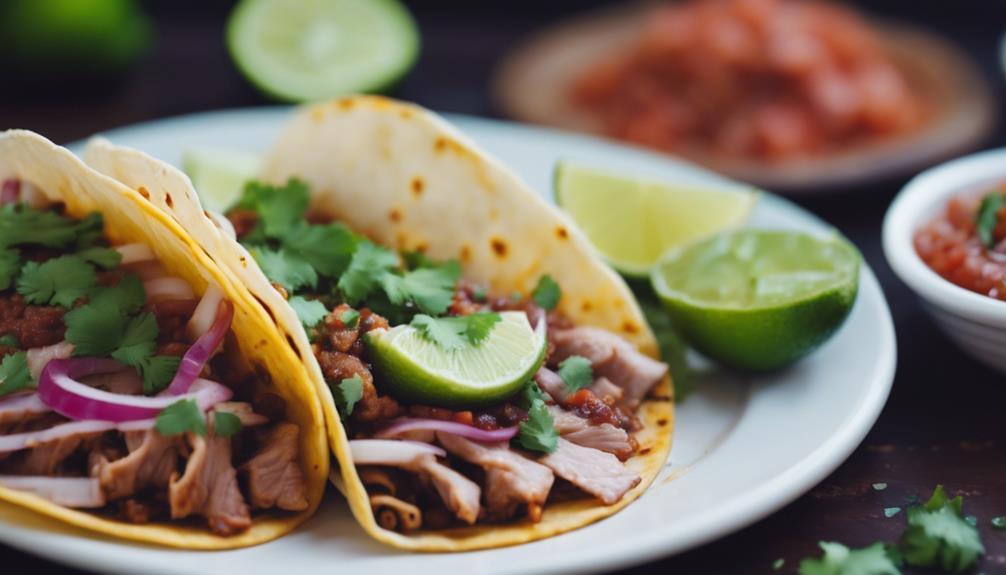The science of crispy fried foods combines heat, chemistry, and technique to create that delightful crunch you love. When you submerge food in oil heated between 175-190°C (350-375°F), it triggers the Maillard reaction, enhancing flavor and creating that golden-brown appearance. Maintaining this ideal oil temperature is essential to avoid sogginess and burning. Ingredients like cornstarch contribute to a crunchier texture, while herbs and spices can elevate flavor profiles. Understanding these elements not only improves your frying skills but also transforms your meals. If you're curious about more tips and techniques, there's a lot more to explore!
Key Takeaways
- Frying at the ideal oil temperature (175-190°C / 350-375°F) ensures a crispy texture and minimizes oil absorption.
- The Maillard reaction enhances flavor and browning, requiring temperatures above 120°C (248°F) during frying.
- Quality of batter, such as using cornstarch or rice flour, significantly impacts the crunchiness of fried foods.
- Maintaining consistent oil temperature prevents sogginess and uneven cooking, essential for achieving the perfect crispiness.
- Incorporating herbs and spices in batters can elevate flavor profiles, making fried foods more enjoyable.
Origins of Fried Foods
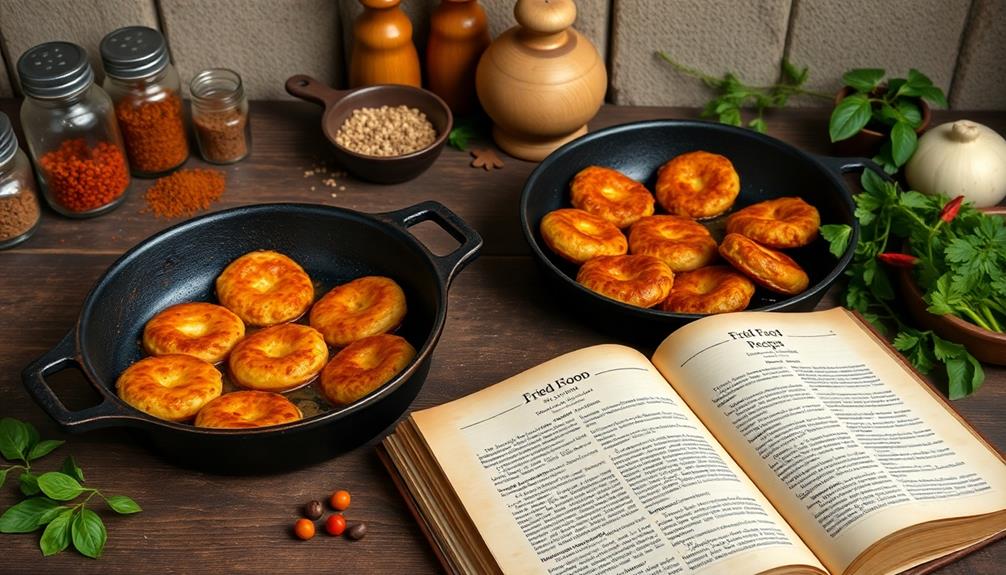
Fried foods have a rich history that dates back over 4,500 years, with ancient civilizations like the Egyptians and Greeks already using oil for cooking by 2500 BCE. This method likely evolved as a way to enhance flavors and preserve food, especially in regions where climate conditions made preservation necessary.
As you explore the history of fried foods, you'll find that by the Middle Ages, these delicious dishes gained popularity across Europe. Countries like France and Italy embraced frying, often associating it with festive occasions and culinary innovation.
In Chinese cuisine, dishes such as Chicken Feet (Dim Sum Style) exemplify the delightful textures that frying can create, becoming a beloved part of social dining experiences.
The technique of deep frying became widespread in the 19th century, coinciding with advancements in cooking technology and the availability of refined oils. This shift marked a turning point in the chemistry of frying, where the right oil could produce crispy textures and rich flavors that have become a staple in many cuisines.
Even today, modern street food culture, especially in South Asia, celebrates fried foods as comfort and communal dishes, often enjoyed during festivals and social gatherings.
The history of fried foods showcases their enduring appeal, drawing you into a world of flavor that transcends time and culture.
The Science of Frying
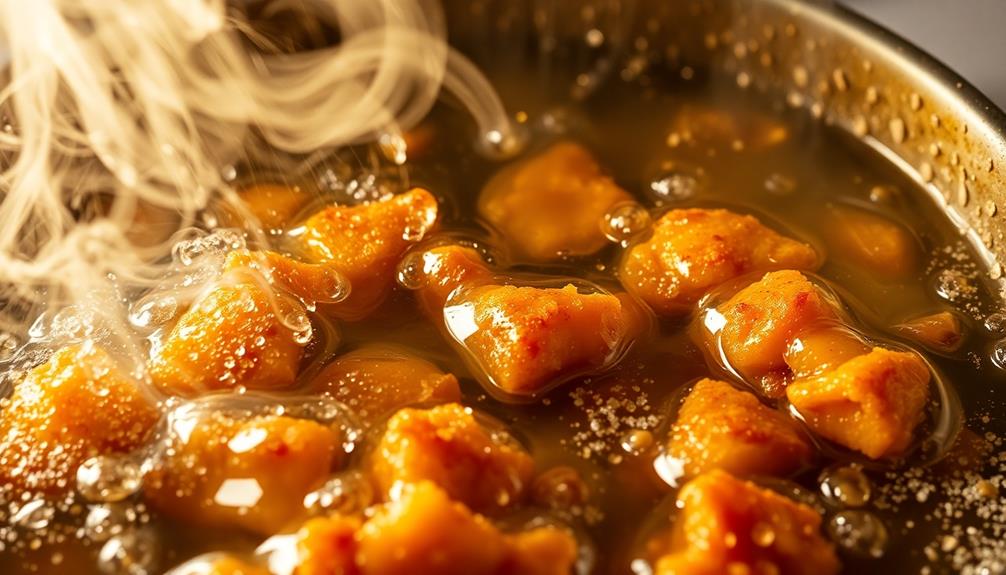
The science behind frying reveals a fascinating interplay of heat, chemistry, and texture. When you submerge food in hot oil, typically between 175-190°C (350-375°F), the rapid heat transfer creates a crispy texture on the outside while thoroughly cooking the inside.
Key factors in this process include:
| Factor | Description |
|---|---|
| Oil Temperature | Essential for preventing greasiness and burning |
| Maillard Reaction | Enhances flavor and browning through a chemical process between amino acids and sugars |
| Water to Steam | Converts rapidly, forming bubbles that protect food from excessive oil absorption |
| Oil Choice | High smoke point oils like canola or peanut enhance flavor and texture |
| Cooking Time | Balances texture and doneness for ideal results |
Maintaining the right oil temperature is vital; too low, and your food becomes greasy; too high, and it burns. The Maillard reaction not only creates that delicious golden-brown color but also intensifies flavor. Understanding these elements helps you achieve that perfect crispy fried food you crave.
Key Chemical Reactions

During frying, key chemical reactions transform simple ingredients into delicious, crispy delights. One of the most important reactions is the Maillard reaction, which occurs between amino acids and reducing sugars at high temperatures, typically above 120°C (248°F). This reaction is essential for browning and flavor development in your fried foods, such as the beloved Fried Pork Chops that are famous in Southern cuisine.
As you fry, the water inside the food rapidly converts to steam, creating pressure that helps form a crispy outer layer while minimizing oil absorption. To enhance the Maillard reaction, it's critical to maintain the ideal oil temperature, around 175-190°C (350-375°F). At this temperature, dicarbonyls produced during the Maillard reaction can interact with amines, generating Strecker aldehydes that contribute to the savory flavors you love.
Additionally, the formation of glycosylamines and other compounds during this cooking process creates complex flavor profiles and appealing aromas, making your fried dishes irresistible.
Factors Influencing Crispiness
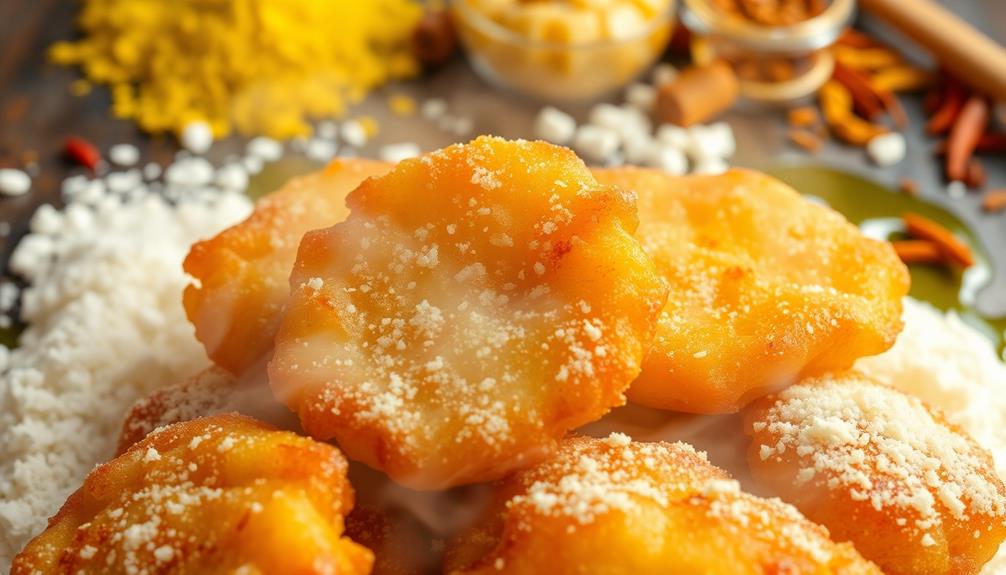
Achieving that perfect crispiness in fried foods involves several key factors that work together to create an irresistible texture. One of the most critical elements is temperature.
You'll want to maintain an oil temperature of around 175-190°C (350-375°F). If the temperature drops too low, the food absorbs excess oil, becoming soggy. Conversely, if it's too high, you risk burning the outside while leaving the inside undercooked.
Additionally, the choice of ingredients can influence the final texture; for instance, using cassava in certain batters can yield a unique crunch that enhances the overall experience.
Another important factor is the quality and type of batter. Batters containing cornstarch or rice flour yield a crunchier texture compared to those made solely from wheat flour.
The Maillard reaction plays a crucial role here, as it not only contributes to the appealing browning of the food but also enhances its flavor and texture.
Temperature Control Techniques

When it comes to frying, maintaining the right oil temperature is fundamental for that perfect crispy finish. You should aim to keep your oil between 175-190°C (350-375°F). This range is essential for achieving a crispy texture while minimizing oil absorption in your food.
Using a deep-fry thermometer is an effective way to guarantee accurate temperature control, preventing greasy or burnt results. Always preheat your hot oil before adding food; this helps create a protective steam barrier that reduces oil penetration. Avoid overcrowding your frying vessel, as this can lower the oil temperature noticeably, leading to uneven cooking and sogginess. Instead, fry in small batches to maintain ideal heat. This method not only ensures a crispy, golden exterior, but also locks in moisture for juicy, flavorful results. Additionally, using a deep-fry thermometer allows for precise cooking times, resulting in consistently perfect dishes. These are some of the reasons why restaurants use sous vide cooking, as it allows for exact temperature control and produces consistently excellent results.
Monitoring the frying process is crucial. Keep an eye on the bubbling and the golden-brown color, as these cues will help you determine the ideal cooking time for crispiness.
| Temperature (°C) | Result | Ideal Cooking Time |
|---|---|---|
| 175-190 | Crispy texture | Varies by food type |
| Below 175 | Soggy food | Increases cooking time |
| Above 190 | Burnt exterior | Decrease cooking time |
Health Implications of Frying
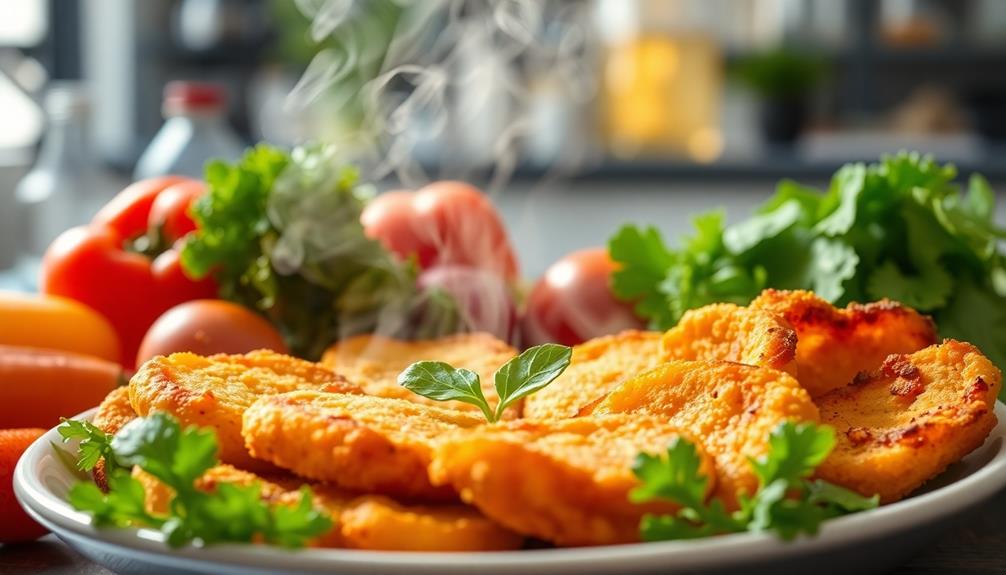
Frying can create deliciously crispy foods, but it also comes with health implications that you should consider. Fried foods often absorb oil, leading to higher calories and fat content, which can raise cholesterol levels and contribute to weight gain if you indulge too much.
Additionally, when foods are fried at high temperatures, a harmful compound called acrylamide can form, especially in starchy items, raising concerns about potential long-term health effects. Dishes like Mushroom Masala offer flavorful alternatives that are vegetarian-friendly and can provide a satisfying texture without the excess oil.
Regular consumption of fried foods has been linked to an increased risk of heart disease and type 2 diabetes. Because of these risks, moderation is key. You might want to choose cooking methods that offer similar textures without the downsides of frying.
For instance, using oils with high smoke points like canola or peanut oil can reduce harmful compound formation, but it's still important to be mindful of portion sizes.
Consider healthier cooking methods like air frying or baking. These alternatives can deliver the crispy satisfaction you crave while greatly lowering the fat and calorie content, making them a better choice for your long-term health.
Cultural Significance of Fried Foods
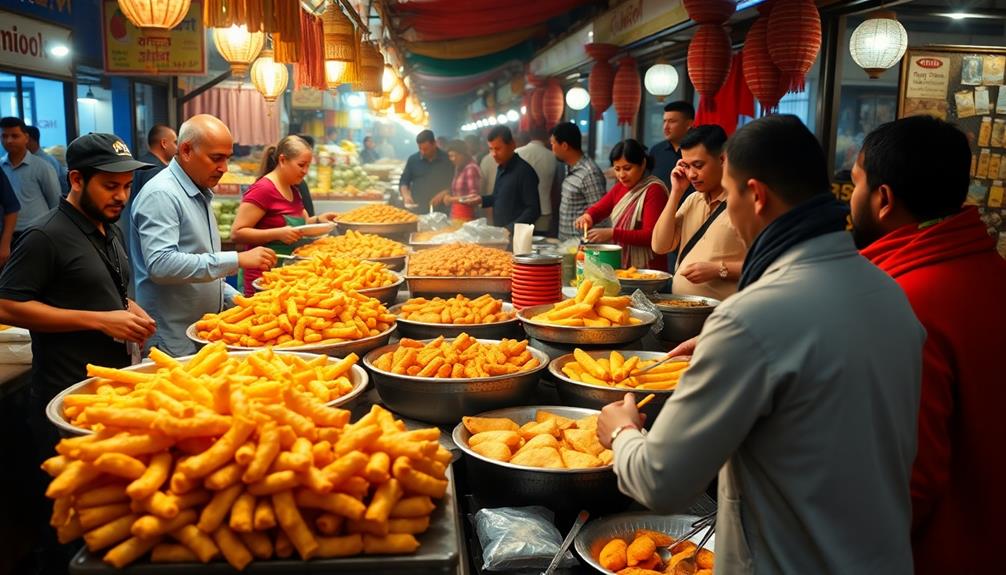
Across the globe, fried foods are more than just meals; they embody cultural traditions and evoke cherished memories. These dishes often serve as comfort food, reminding you of family gatherings and communal events. In South Asian cuisine, for instance, samosas and pakoras are staples during festivals, bringing people together in celebration.
Fried foods hold a significant place in various cultures, showcasing local flavors and techniques. Here's a quick look at some beloved fried dishes from around the world:
| Region | Dish | Cultural Significance |
|---|---|---|
| South Asia | Samosas | Common during festivals and family gatherings. |
| Western Culture | French Fries | A popular side dish, often shared at casual meals. |
| Japan | Tempura | Represents refinement in hospitality and cuisine. |
| Latin America | Empanadas | Enjoyed during communal events and family reunions. |
These examples highlight how fried foods not only satisfy cravings but also symbolize hospitality and togetherness. The historical references to these dishes in ancient texts further underscore their lasting appeal and cultural significance across societies.
Enhancing Flavor in Fried Dishes
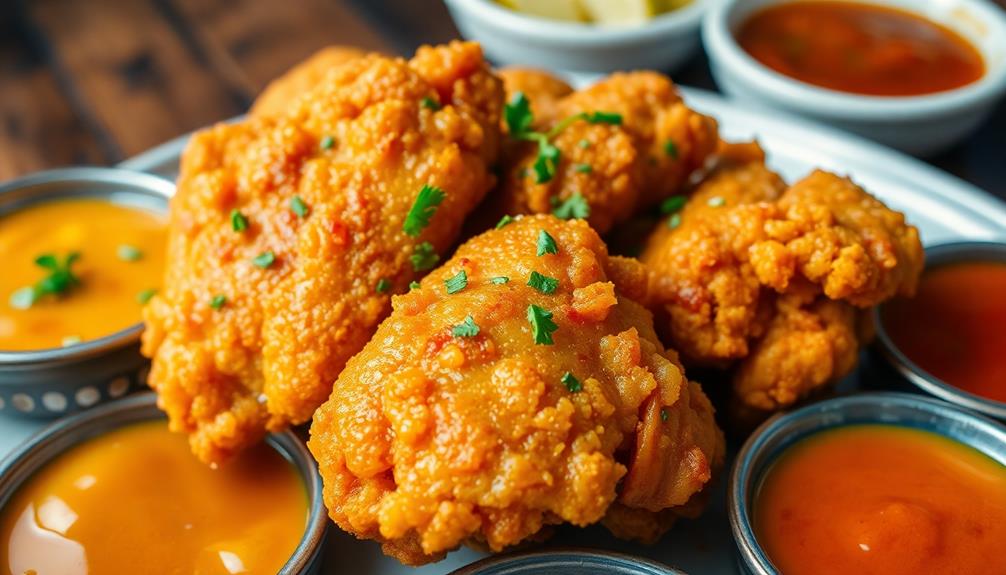
Enhancing the flavor of fried dishes can transform a simple meal into an unforgettable experience. By understanding the science behind frying, you can create dishes that aren't only crispy but also bursting with flavor.
The Maillard reaction plays a vital role here; it occurs at high temperatures, creating complex flavors and appealing aromas as new compounds form. For instance, incorporating elements from traditional Mexican cuisine, such as Chilaquiles' vibrant toppings, can inspire unique flavor combinations in your fried dishes.
To elevate your fried foods, consider these tips:
- Incorporate herbs and spices: Mix them into your batters or marinades to enhance the flavor profile. They cling well to the crispy surfaces during frying.
- Choose your oil wisely: Oils like peanut or sesame bring unique flavors, while neutral oils let the food's natural taste shine.
- Monitor your frying temperature: Aim for around 175-190°C (350-375°F) to guarantee peak flavor development and prevent off-flavors from oil breakdown.
Using lower moisture ingredients like chickpea flour or bread crumbs in your batters can also maximize the Maillard reaction, resulting in a more flavorful and crispy crust.
With these tips, you'll take your fried dishes to new heights!
Frequently Asked Questions
What Makes Fried Foods Crispy?
Fried foods get crispy when you maintain high oil temperatures, allowing moisture to evaporate quickly. Using less-moisture ingredients and avoiding overcrowding guarantees even cooking, creating that delightful crunch you love in your favorite dishes.
What Is the Science Behind Fried Food?
Did you know that frying food can reduce its moisture content by about 80%? The science behind fried food involves heat, oil, and chemical reactions that create textures and flavors you love, enhancing your culinary experience.
What Is the Science Behind Crispy Fries?
To achieve crispy fries, you need to fry them at the right temperature. Blanching first, then frying at higher heat, helps remove moisture while creating a perfect golden-brown color and satisfying crunch you crave.
Why Is Crispy Food Unhealthy?
Crispy foods can be unhealthy because they often absorb excess oil, increasing calorie intake. Regular consumption raises cholesterol levels and may lead to heart disease, obesity, and even type 2 diabetes. Moderation is key for better health.
Conclusion
As you savor that golden, crispy bite, remember the science behind the crunch. Each layer holds secrets of heat and transformation, where simple ingredients become something extraordinary. But as you enjoy, consider the balance—between indulgence and health, culture and innovation. What will you choose next? Will it be a classic or a daring twist? The world of fried foods is vast and tantalizing, and the next crispy creation could be just around the corner, waiting for you to discover it.
